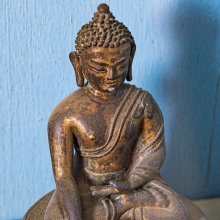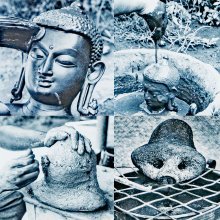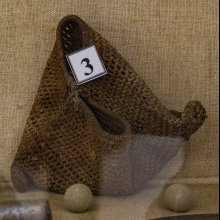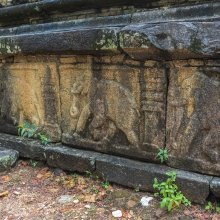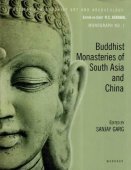Clay: 3 definitions
Introduction:
Clay means something in Hinduism, Sanskrit. If you want to know the exact meaning, history, etymology or English translation of this term then check out the descriptions on this page. Add your comment or reference to a book if you want to contribute to this summary article.
Images (photo gallery)
(+38 more images available)
In Hinduism
Natyashastra (theatrics and dramaturgy)
Source: Shodhganga: Elements of Art and Architecture in the Trtiyakhanda of the Visnudharmottarapurana (natya)Clay is used as a material for creating artificial masks (of gods, demons, animals, etc.) in Indian Dramas, as part of the Prasta division of Āhāryābhinaya: one of the four divisions of Abhinaya or “ways to convey or represent one’s emotion to others”, according to the Viṣṇudharmottarapurāṇa, an ancient Sanskrit text which (being encyclopedic in nature) deals with a variety of cultural topics such as arts, architecture, music, grammar and astronomy.—The Viṣṇudharmottarapurāṇa says that Prasta denotes the making of artificial masks of gods, demons, demi-gods, different animals and birds etc. by clay, wood, cloth, leather and iron. In the Nāṭyaśāstra, the word pusta is used instead of prasta.

Natyashastra (नाट्यशास्त्र, nāṭyaśāstra) refers to both the ancient Indian tradition (shastra) of performing arts, (natya—theatrics, drama, dance, music), as well as the name of a Sanskrit work dealing with these subjects. It also teaches the rules for composing Dramatic plays (nataka), construction and performance of Theater, and Poetic works (kavya).
Vastushastra (architecture)
Source: Shodhganga: Elements of Art and Architecture in the Trtiyakhanda of the Visnudharmottarapurana (vastu)Clay is the primary ingredient for creating Bricks which is an important Material used for the Construction of Walls and Temples, according to the Viṣṇudharmottarapurāṇa, an ancient Sanskrit text which (being encyclopedic in nature) deals with a variety of cultural topics such as arts, architecture, music, grammar and astronomy.—In ancient time bricks used to be made of clay which were of four kinds, ūṣara, pāṇḍura, kṛṣṇacikkaṇa and tāmraputtaka. According to the Mayamata, tāmraputtaka type of clay is the best one for making of bricks.

Vastushastra (वास्तुशास्त्र, vāstuśāstra) refers to the ancient Indian science (shastra) of architecture (vastu), dealing with topics such architecture, sculpture, town-building, fort building and various other constructions. Vastu also deals with the philosophy of the architectural relation with the cosmic universe.
Shilpashastra (iconography)
Source: Shodhganga: Elements of Art and Architecture in the Trtiyakhanda of the Visnudharmottarapurana (shilpa)Clay in used as a basic ingredient in the process of creating a Canvas, in the ancient Indian art of Painting (citra), according to the Viṣṇudharmottarapurāṇa, an ancient Sanskrit text which (being encyclopedic in nature) deals with a variety of cultural topics such as arts, architecture, music, grammar and astronomy.—In the Viṣṇudharmottarapurāṇa, it is suggested that before going to start Painting on walls one should plaster a wall. For the process of kuḍya i.e., plastering on a wall, the painter needs iṣṭakācūrṇa i.e., powder of bricks and mṛd i.e., clay as basic ingredients. To prepare this at first the powder of three kinds of brick and one third of clay should be mixed.

Shilpashastra (शिल्पशास्त्र, śilpaśāstra) represents the ancient Indian science (shastra) of creative arts (shilpa) such as sculpture, iconography and painting. Closely related to Vastushastra (architecture), they often share the same literature.
See also (Relevant definitions)
Starts with: Claytonia lanceolata, Claytonia multicaulis, Claytonia perfoliata, Claytonia sibirica, Claytonia tuberosa, Claytonia virginica.
Full-text (+679): Mrittika, Mrin, Gopicandana, Mritpinda, Jambala, Loshta, Kashthaloshtamaya, Amakumbha, Pusta, Mritpatra, Ghataraja, Tilaka, Mrinmaya, Mattika, Loshtamaya, Mrilloshta, Mrida, Amapatra, Krishnabhumi, Shilindhri.
Relevant text
Search found 238 books and stories containing Clay; (plurals include: Claies). You can also click to the full overview containing English textual excerpts. Below are direct links for the most relevant articles:
Taittiriya Upanishad Bhashya Vartika (by R. Balasubramanian)
Verse 2.135 < [Book 2 - Brahmavallī]
Verse 2.381 < [Book 2 - Brahmavallī]
Verse 3.24 < [Book 3 - Bhṛguvallī]
The Shiva Purana (by J. L. Shastri)
Chapter 20 - Rules for hair-cutting and ablution < [Section 6 - Kailāsa-saṃhitā]
Chapter 20 - Worshipping an earthen phallic image by chanting Vedic mantras < [Section 1 - Vidyeśvara-saṃhitā]
Chapter 36 - Installation of Śiva < [Section 7.2 - Vāyavīya-saṃhitā (2)]
Sripura (Archaeological Survey) (by Bikash Chandra Pradhan)
Clay Sculptures < [Chapter 3 - Sculptural Programme]
Stone Inscriptions < [Chapter 4 - The Corpus of Inscriptions]
Tivaradeva Vihara (SRP-5) < [Chapter 2 - The Architectural Panorama]
Brahma Sutras (Nimbarka commentary) (by Roma Bose)
Brahma-Sūtra 2.1.14 < [Adhikaraṇa 6 - Sūtras 14-19]
Brahma-Sūtra 1.4.23 < [Adhikaraṇa 7 - Sūtras 23-27]
Brahma-Sūtra 2.1.13 < [Adhikaraṇa 5 - Sūtra 13]
Garga Samhita (English) (by Danavir Goswami)
Verse 1.18.13 < [Chapter 18 - Vision of the Universal Form]
Verse 1.18.15 < [Chapter 18 - Vision of the Universal Form]
Verse 5.24.23 < [Chapter 24 - The Killing of the Kola Demon]
The civilization of Babylonia and Assyria (by Morris Jastrow)
Related products
